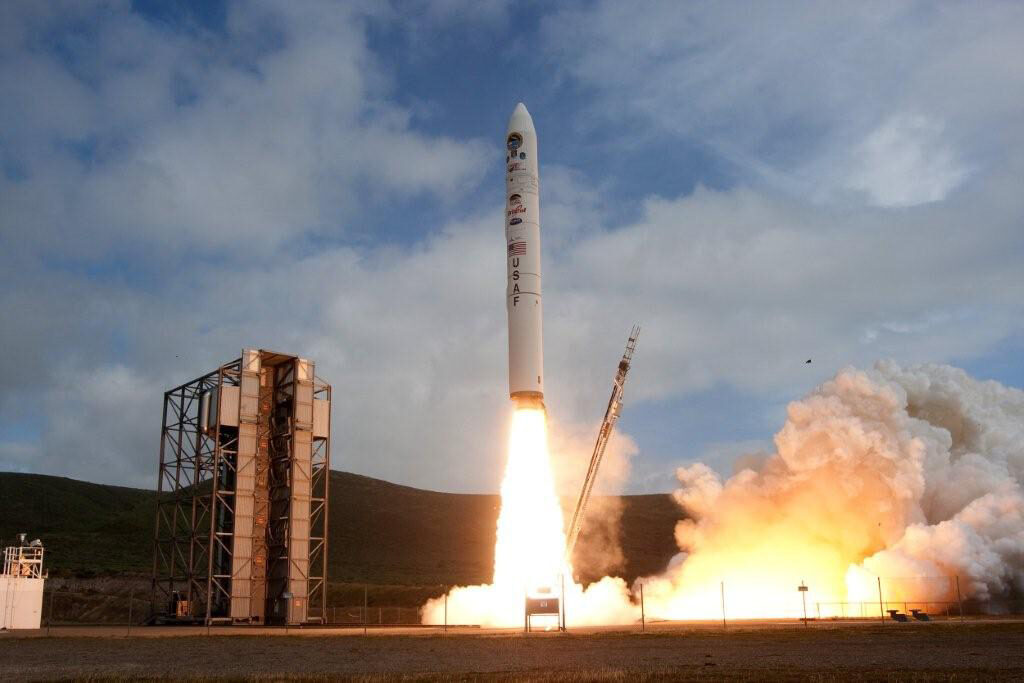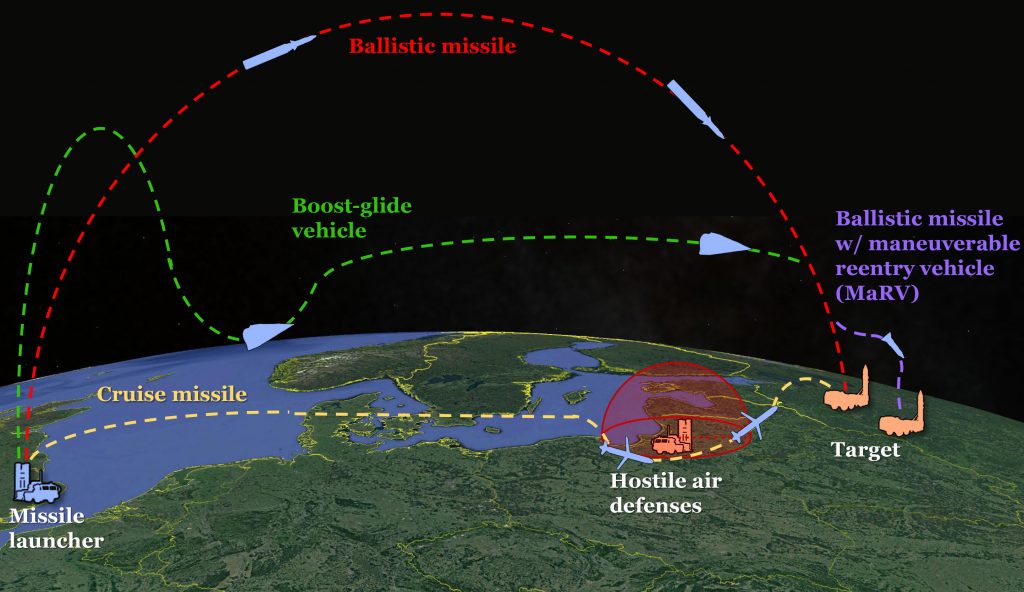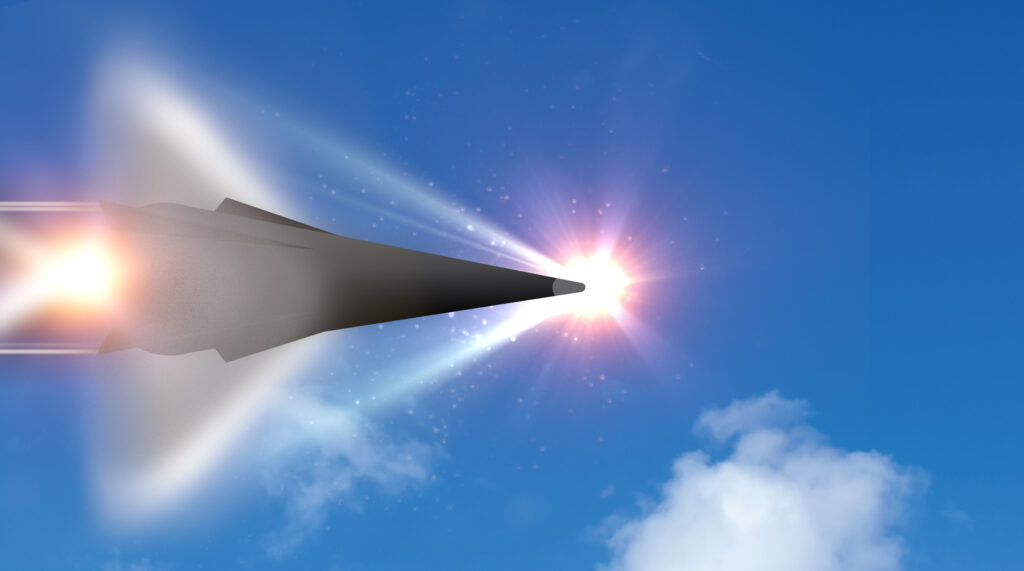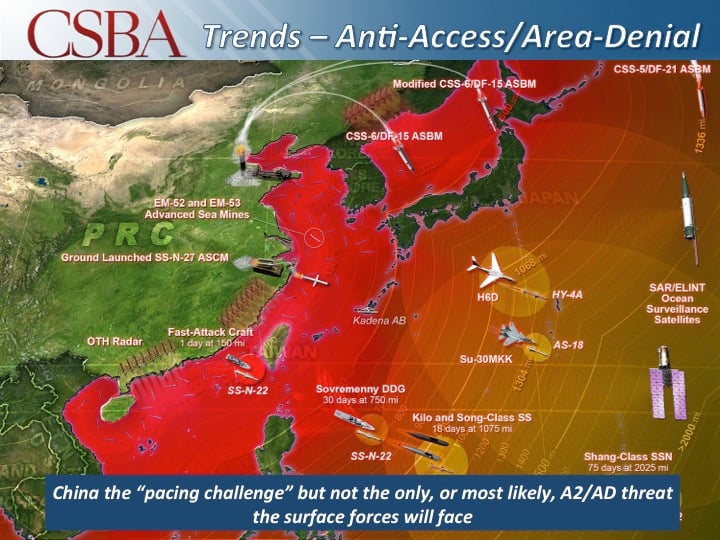
WASHINGTON: Are hypersonic weapons worth it? That’s the debate between the Pentagon and the Union of Concerned Scientists, a pro-arms-control group that recently released a study arguing the new missiles offer marginal improvement at high cost. But both the Pentagon’s principal director for hypersonics research & development, Michael White and independent defense experts tell us the UCS study is deeply flawed.
We overviewed their arguments yesterday: Click here to read Part I.
In this story, we dive in deep, going point by point throughout the flight path of a hypersonic boost-glide weapon and comparing the UCS analysis with its critiques.
In essence, the critics argue the Union of Concerned Scientists got something wrong at every step of their analysis, from the technical details to the strategic implications.

- UCS based their model on decade-old flight tests of an experimental DARPA design, HTV-2, which never completed a full flight test and is very different from the newer hypersonics weapons now in development.
- UCS graded the model on two key metrics, flight time and detectability. They concluded the hypersonic weapon would reach the US from Russia, a 5,000 mile flight, only five minutes faster than a traditional ICBM, and it could be readily detected en route by existing early-warning satellites. But they didn’t refute the larger reason America’s adversaries are pursuing hypersonics: It’s not their raw speed, but the fact that they’re much more maneuverable than ballistic missiles, allowing them to evade existing missile defenses – which the UCS study acknowledges hypersonics can do.
- Finally, UCS compares hypersonics to an ICBM. But while China and Russia are developing hypersonics for nuclear-armed, intercontinental strike, the US is not. Instead, every single American program is a non-nuclear weapon for precision-guided intra-theater strike. For warfare at theater ranges, a fraction of the 5,000-mile intercontinental strike that the study modeled, the US currently relies on cruise missiles and manned aircraft, which are many times slower than hypersonics and are believed to be much easier for the enemy to shoot down.
In the Pentagon’s current plans, hypersonics won’t replace cruise missiles or planes for the bulk of long-range strikes, but a relatively small number of hypersonic weapons can penetrate cutting-edge air defenses, destroy well-protected vital points and break open the enemy defensive network for the rest of the force to follow.
To evaluate these arguments, you need to delve into both the physics and the strategy.

The Physics
Let’s start with the basics. Why are the militaries of the US, Russia, and China so intrigued by hypersonics? The answer is simple: because the physics of how they fly is very different from traditional missiles.
Ever since World War II, when Germany bombarded Britain with its V-1 and V-2 “vengeance weapons,” militaries have used two types of long-range missiles:
- Cruise missiles, like the V-1, are basically unmanned jets, flying through the atmosphere like a plane. That allows them to maneuver – flying under radar, circling around anti-aircraft defenses, dodging flak – but limits them to altitudes and speeds at which their engines can generate thrust and their wings can generate lift. Cruise missiles vary widely. The fastest fielded models are supersonic; most, like the American Tomahawk, are subsonic.
- Ballistic missiles, like the V-2, fly like cannonballs on a fixed trajectory. A rocket booster launches them out of the atmosphere to the fringes of outer space, then gravity pulls them down. That means they fly much faster and higher than cruise missiles, at Mach 20-plus, but they’re much less maneuverable. Even when fitted with “maneuvering reentry vehicles” that let the warhead change course as it reenters the atmosphere, ballistic weapons have only limited ability to change their path and point of impact.
Hypersonic boost-glide weapons combine some attributes of cruise and ballistic missiles, with some of the strengths and weaknesses of both. They’re launched on rocket boosters, like a ballistic missile, but then they detach and glide through the atmosphere, much like a cruise missile.
While they fly lower and slower than ballistic missiles, hypersonic glide bodies fly much higher and faster than traditional cruise missiles, because they fly through higher and thinner regions of the atmosphere: DARPA says its experimental HTV-2 maxed out at Mach 20. And while they’re much less maneuverable than cruise missiles – all that speed makes it hard to turn – they’re much more maneuverable than ballistic missiles, even ones with maneuvering reentry vehicles. That makes them harder to track and harder to shoot down.
(There’s also a separate class of “air-breathing” hypersonic cruise missiles, but these operate at much lower speeds and altitudes than boost-glide missiles, although they’re still hypersonic, meaning they fly at Mach 5-plus. They’re also more maneuverable than boost-glide weapons, and some experts argue that makes them militarily more promising. But they’re not the topic of the UCS study and its physics models don’t apply to their very different form of flight).

The Russian Avangard missile and the Chinese DF-17 are both hypersonic boost-glide missiles. So is the Army-Navy Common Hypersonic Glide Body, which will be launched from trucks, surface ships and submarines, and the Air Force’s ARRW, a smaller weapon that can be launched from planes.
Is DARPA’s HTV-2, which last flew in 2011, a good model for how these newer hypersonic weapons work?
The UCS study acknowledges that new designs with improved performance would significantly change their calculations, especially glide bodies with a better ratio of lift to drag. But Cameron Tracy, lead author of the study, told me he’s seen no evidence the new designs are significantly better.
“It is easy to say that some secret characteristic of other hypersonic weapons happens to make them vastly superior, [but] without data to support that assertion, it is ultimately meaningless,” the UCS scientist said. “‘Just trust me’ is a scientifically uninteresting statement.”
There’s no public peer review of classified Pentagon data, of course. But there are at least two independent parties with enough data to make their own assessments — Russia and China – and they’ve independently chosen to invest heavily in hypersonics.
“I would suspect the Russians and the Chinese have more insight into the value proposition than these two scientists [from UCS] who don’t have access to the classified data,” one defense official told us.

Early Warning & Detection
Because hypersonic glide bodies fly so differently from existing missiles, the Pentagon wants to build new system to better detect and track them: the Hypersonic & Ballistic Tracking Space Sensor (HBTSS), which will go on the Space Development Agency’s Tracking Layer satellites.
The Union of Concerned Scientists says this investment is not necessary. Using published data on the decades-old DSP (Defense Support Program) early warning satellites, and some informed speculation on the newer SBIRS (Space-Based Infra-Red System), they argue these systems can pick up the extreme heat both of a hypersonic booster-rocket launch and of a hypersonic glide body blazing through the atmosphere, which can heat the glider’s surface to more than 3,000 degrees.
“For DSP, the older system, it’s a little less sensitive, so … especially when a glider is flying near the poles… you might lose continuity of tracking,” Tracy told me. “SBIRS, the newer system…appears to be capable of tracking the flight of a hypersonic glider for nearly the entirety of its glide phase.”
That should be good enough for all practical purposes, the UCS scientist said. “If you’re worried about knowing a missile is coming towards you,” he told me, the new HBTSS is “unnecessary.”
“If the goal was some extremely advanced defense system that could pinpoint the location of a hypersonic glider within some tiny spatial accuracy at any point in flight,” Tracy allowed, “then, okay, you could make an argument you need more satellites.”

But that is, in fact, the argument the Pentagon is making. While existing satellites may be able to detect a hypersonic launch, White told me, it’s much harder to track the glide body itself precisely and continuously enough to help missile defenses set up an intercept. Hypersonics are so much more maneuverable than ballistic missiles that you can’t afford to lose track of them for any significant stretch of their flight.
“They argue you can detect hypersonic glide bodies from space, but detection is just one part, a necessary but not nearly sufficient part, of the fire control needed to intercept,” he said. “You have to be looking in the right place at the right time and then flight within the atmosphere enables unpredictable maneuvering which makes closing the fire control loop very difficult.”
“With a ballistic launch, you can calculate the trajectory to get a fire control solution, because the only force acting on the body after boost is gravity, so you can pretty much tell where an reentry vehicle is going to be at any point in its trajectory and where it’s going to hit,” White said. “Hypersonic systems can be launched in a completely different direction, maybe even fly around a detection and tracking radar’s search sector, and not be detected. Even if they are detected from space or ground sensors, the ability to decide where that threat is going, what targets are at risk, and how to react becomes infinitely more complicated.”
“The paper presents a lot of analysis on infrared detection of hypersonic warheads, which is not really in contention,” agreed Bryan Clark, a retired Navy strategist and submariner now with the Hudson Institute. “Rather, the advantage of hypersonic boost-glide weapons is in engagement.” That is, they’re very hard for existing missile defenses to shoot down.
(This is similar to the argument of those who argue that stealth aircraft can be spotted by low frequency radar and thus stealth is no longer useful. Those radar can detect the aircraft at distance but they are not precise enough to target an aircraft. Higher frequency targeting radars cannot reliably spot stealthy aircraft well enough to target them.)

Missile Defense
Surprisingly, the UCS and its critics are in full agreement on one thing. Hypersonic glide bodies are much harder to intercept than existing ballistic or cruise missiles. What they disagree on is whether it matters.
America’s existing Ground-Based Interceptor (GBI) and sea-launched SM-3 Standard Missile both engage ICBMs as they fly through space. But hypersonic glide bodies remain in the atmosphere throughout their flight, shielding them from these exoatmospheric systems. Other systems such as Patriot and THAAD shoot down aircraft, cruise missiles, and shorter-ranged ballistic missiles inside the atmosphere, but they can’t handle the sheer speed of hypersonic weapons.

Hypersonic boost-glide vehicles “spend most of their time at an altitude below the mid-course engagement possible with NGI [Next-Generation Interceptor], GBI [Ground-Based Interceptor], and SM-3, and above the terminal engagement possible with THAAD or [Patriot] PAC-3,” said Clark. “And when they do go [lower] into terminal attack, hypersonic warheads come at the target much faster than supersonic cruise missiles, making them hard to engage with surface-to-air-missiles designed to defeat ballistic or cruise missiles of today.”
The Union of Concerned Scientists come to the same conclusion. “During their glide and terminal phases hypersonic weapons would fly at altitudes too low for interception by defenses designed to intercept ballistic missiles above the atmosphere,” the UCS study says. “Endoatmospheric defenses such as the US Patriot and THAAD systems operate within the atmosphere, but are designed to intercept warheads from missiles with shorter ranges and slower speeds than ICBMs.”
But, Tracy argued, that doesn’t matter, because existing missile defenses can’t stop a Chinese or Russian salvo with hundreds or thousands of ICBMs, either. “They can be overcome by just firing more missiles than there are interceptors,” he said.
It’s absolutely true, White told me, that no existing US missile defense system is designed to stop an all-out Russian or Chinese intercontinental ballistic missile strike. “Right now, for the most part, our ballistic missile system is designed to handle rogue nation threats,” he said. “In a large-scale exchange, we still rely by policy on mutual assured destruction” – the same strategy of deterrence that got us through the Cold War.
MAD, however, is not something you want to invoke in a conventional theater war. Threatening nuclear strikes tends to escalate the situation, to say the least. So when an adversary launches a conventional strike at an intra-theater target, the US military relies on air & missile defenses for protection and on its own conventional weapons for retaliation.
That’s part of the reason the US is investing so heavily in theater (but not intercontinental) hypersonic weapons with precision-guided conventional (not nuclear) warheads. And in the theater fight, the speed of hypersonic weapons poses a very different problem than in the intercontinental arena.

Time To Target
How big of an advantage is hypersonic speed? The answer depends on the kind of distances you’re talking about and what kind of weapon you’re comparing them to.
When it comes to intercontinental strikes, hypersonics have at best a modest edge. They don’t actually fly at a higher speed than ICBMs, but they do travel a shorter distance, because they skim through the upper atmosphere rather than taking a long, parabolic path through outer space. That potentially gives hypersonics a shorter “time to target” and gives their targets less time to react.
“We were most interested, at the core, in this question of delivery time, because that seem to be the most common misconception about hypersonic performance,” Tracy told me. “So, to that end, we wanted to model the fastest possible hypersonic weapon.”
What did Union of Concerned Scientists find? In their model, the hypersonic glider did reach its target somewhat faster than an ICBM flying the traditional high-efficiency, “minimum energy” trajectory, which allows the maximum range for a given booster rocket and weight of payload.
But the advantage is about five minutes. If an ICBM can fly from Russia to the US in 30 minutes, they calculate, a glide body similar to HTV-2 can make it in 25. And if you fire your ICBMs in a depressed trajectory – which does sacrifice some range and/or payload – they can make the same flight even faster than the hypersonic weapon can.
That intercontinental time-to-target math checks out, White said, but it misses the point. “That is not the relevant metric,” he told me. Neither the US nor its adversaries are pursuing hypersonics because they reach an intercontinental target “five minutes or 10 minutes faster” than ICBMs.
Our experts agreed that Russia and China are pursuing hypersonic missiles for intercontinental, nuclear missions because they can outmanuever existing missile defenses, not because they arrive at the target any faster. And the US isn’t pursuing intercontinental (or nuclear) hypersonics at all. Instead, the US is developing a family of theater-range, conventionally armed weapons, launched from land, sea, and air.
That means, for the American arsenal, the relevant time-to-target comparison isn’t with ICBMs, but with existing intra-theater, non-nuclear weapons. And there the difference is dramatic.
A hypersonic glide body boosted to speeds up to 20 times the speed of sound performs a mission dramatically faster than the subsonic bombers – B-52s, B-1s, and the future B-21 – or subsonic cruise missiles that make up almost all of America’s theater-range strike force today. Those speed differences can turn a long-range strike mission that today takes a flight time of two or more hours into a mission with a flight time of 10 to 20 minutes.
Two hours is plenty for time for an adversary to scramble fighters, reload surface-to-air missile launchers, and relocate mobile launchers, radars, and command posts to new locations. Ten minutes is not.
“Hypersonic missiles dramatically compress the time scale of the theater fight,” White said. “That capability is critically important to us maintaining battlefield dominance, especially when the adversary is operating with ballistic and hypersonic systems on that compressed timescale.”

The Strategic Rationale
Not every target requires the lightning-fast, missile-defense-defeating performance of hypersonics, White told me – only the most important and best-defended. The vast majority of the force will remain subsonic.
“The hypersonic theater range capabilities we are developing use conventional warheads, and they enable us to have time-critical, highly responsive strike from long range with very survivable weapons to go after high-value targets,” he said. In particular, hypersonics can target the high-end air and missile defense systems that keep our subsonic missiles and aircraft at bay, opening flight paths for those slower but more affordable systems to take out other targets.
“The actual purpose for all of our investment is to supplement our existing theater strike capability using traditional cruise missiles, as well as penetrating aircraft,” White told me. “Just as an example, if we have a target that’s very heavily defended with a high-end integrated air defense system (IADS), hypersonic strike systems allow us to rapidly take out that IADS from long range with highly survivable, lethal effects so that we can then bring in the traditional capabilities in mass.”
If this combination of hypersonic and subsonic weapons sounds familiar, it should. It’s the same kind of one-two punch that the US plans to use with its stealthy and non-stealthy aircraft. The F-35s, F-22s, B-2s, and future B-21s are meant to sneak past enemy radar, cripple enemy air defenses and open strike corridors for the much larger force of older, more detectable aircraft.
In other words, stealth and hypersonics are complementary solutions to the same problem, what the military analysts call anti-access/area denial (A2/AD). Stealth evades detection; hypersonics evade interception. In layman’s terms, the issue is the increasing ability of sophisticated adversaries like Russia and China, or even Iran and North Korea, to detect and destroy traditional US forces on the land, on the sea, in the air, and even in orbit.
That’s a problem the Pentagon is deadly serious about solving, and it’s not putting all its eggs in any one basket. Instead, it’s making a host of high-tech investments beyond hypersonics, from laser weapons for missile defense to AI-driven command networks to keep up with the pace of modern combat.
So the Biden Administration can’t address hypersonics in isolation. It has to assess them in the context of a much wider modernization drive to maintain American advantage over increasingly high-tech adversaries.

